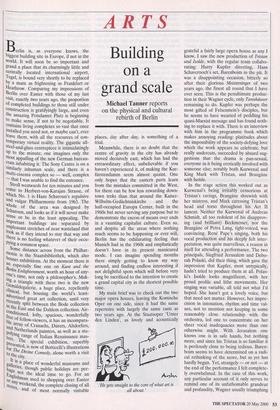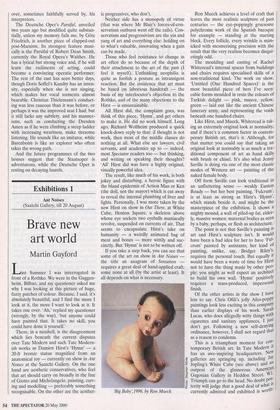ARTS
Building on a grand scale
Michael Tanner reports on the physical and cultural rebirth of Berlin Eierlin is, as everyone knows, the biggest building site in Europe, if not in the World. It will soon be so important and grand a place that its charmingly little and Centrally located international airport, Tegel, is bound very shortly to be replaced by a maze as frightening as Frankfurt or Heathrow. Comparing my impressions of Berlin over Easter with those of my last visit, exactly two years ago, the proportion of completed buildings to those still under construction is gratifyingly large, and even the amazing Potsdamer Platz is beginning to make sense, if not to be negotiable. It contains living complexes so vast that once installed you need not, or maybe can't, ever leave them, with all the resources of con- temporary virtual reality. The gigantic all- steel-and-glass centrepiece is intimidatingly up to the minute; one imagines only the Most appalling of the new German bureau- crats inhabiting it. The Sony Centre is on a similarly inhuman scale, and there is a multi-cinema complex so — well, complex that I was unable to find the entrance.
Stroll westwards for ten minutes and you come to Herbert-von-Karajan Strasse, of Which No. 1 is Hans Scharoun's repulsive and vulgar Philharmonie from 1963. The Whole of the area was designed by Seharoun, and looks as if it will never make sense or be in the least appealing. The important buildings are separated by unpleasant stretches of near wasteland that look as if they intend to stay that way and there is no feeling whatever of their occu- pying a common space. Some distance across from the Philhar- monie is the Staatsbibliothek, which also houses exhibitions. At the moment there is an especially fine one on Kant and the Berlin Enlightenment, worth an hour of any- One's time, not only a philosopher's. Mak- ing a triangle with these two is the new "einaldegalerie, a huge place, repellently clinical, but housing the world's least- "uvertised great art collection, until very r. eeently split between the Bode collection In the East and the Dahlem collection. Air- conditioned, lofty, spacious, wonderfully free of fellow-viewers, it has an incompara- ble array of Cranachs, Diirers, Altdorfers, and Netherlands painters, as well as a stu- PefYing range of Italian Renaissance mas- ters. The special exhibition, superbly presentee is now of Botticelli's illustrations for The Divine Comedy, alone worth a visit to the city, It is a place of wonderful museums and ga oh, ieries, though public holidays are per- haps not the ideal time to go. For an rglishman used to shopping over Easter s, a eekend, the complete closing of all "ny Weekend, and of most normally visitable places, day after day, is something of a trial.
Meanwhile, there is no doubt that the centre of gravity in the city has already moved decisively east, which has had the extraordinary effect, unbelieVable if you haven't experienced it, of making the Kur- fiirstendamm seem almost quaint. One only hopes that the eastern parts learn from the mistakes committed in the West, for there can be few less rewarding down- town treks than that around the Kaiser- Wilhelm-Gedachtniskirche and the half-occupied Europa Center, built in the 1960s but never serving any purpose but to demonstrate the excess of means over ends in a vaunting capitalist culture. Even so, and despite all the areas where nothing much seems to be happening or ever will, Berlin has the exhilarating feeling that Munich had in the 1960s and emphatically doesn't have in its present manicured mode. I can imagine spending months there simply getting to know my way around, and finding endless interesting if not delightful spots which will before very long be sacrificed to the intention to create a grand capital city in the shortest possible time.
My main brief was to check out the two major opera houses, leaving the Komische Oper on one side, since it had the same repertoire with largely the same casts as two years ago. At the Staatsoper `Unter den Linden', as lovely and acoustically `He gets straight to the core of what art is all about.' grateful a fairly large opera house as any I know, I saw the new production of Tristan and Isolde, with the regular team collabo- rating: Harry Kupfer directing, Hans Schavemoch's set, Barenboim in the pit. It was a disappointing occasion, bitterly so after their glorious Meistersinger of two years ago, the finest all round that I have ever seen. This is the penultimate produc- tion in their Wagner cycle, only Tannhauser remaining to do. Kupfer was perhaps the most gifted of Felsenstein's disciples, but he seems to have wearied of peddling his quasi-Marxist message and has found noth- ing to replace it with. There is an interview with him in the programme book which makes annoying reading: platitudes about the impossibility of the society-defying love which the work appears to celebrate, but really undercuts, succeeded by absurd sug- gestions that the drama is pan-sexual, everyone in it being erotically involved with someone else; notably both Kurwenal and King Mark with Tristan, and Brangane with Isolde.
In the stage action this worked out as Kurwenal's being irritably censorious at Tristan's ravings, Brangane shrewish with her mistress, and Mark caressing Tristan's head and torso throughout his Act II lament. Neither the Kurwenal of Andreas Schmidt, all too redolent of his disapprov- ing (and brilliant) Beclunesser, nor the Brangane of Petra Lang, tight-voiced, was convincing. Rene Pape's singing, both his vocal production and his deeply felt inter- pretation, was quite marvellous, a reason in itself for attending a performance. The two principals, Siegfried Jerusalem and Debo- rah Polaski, did their thing, which gave the impression that Kupfer, most untypically, hadn't tried to produce them at all. Polas- ki's Isolde looks magnificent, with her proud profile and lithe movements. Her singing was variable, all told not what I'd hoped. She hasn't got a lovely voice, but that need not matter. However, her impre- cision in intonation, rhythm and time val- ues, not to mention not keeping in some reasonably close relationship with the orchestra, led one to concentrate on her sheer vocal inadequacies more than one otherwise might. With Jerusalem one knows one is in safe hands, but nothing more, and since his Tristan is so familiar it is perilously close to being tedious. Baren- boim seems to have determined on a radi- cal rethinking of the score, but as yet has hardly begun. Yet, strangely — or not — at the end of the performance I felt complete- ly overwhelmed. In the case of this work, any particular account of it only serves to remind one of its unfathomable grandeur and profundity, Wagner usually triumphing over, sometimes faithfully served by, his interpreters.
The Deutsche Oper's Parsifal, unveiled two years ago but modified quite substan- tially, unless my memory fails me, by Gotz Friedrich, is another piece of clapped-out post-Marxism. Its strongest feature musi- cally is the Parsifal of Robert Dean Smith, currently the Royal Opera's Walther. He has a lyrical but strong voice and, if he will learn the rudiments of acting, could become a convincing operatic performer. The rest of the cast has seen better days, though Doris Soffel's Kundry has an inten- sity, especially when she is not singing, which makes her vocal torments almost bearable. Christian Thielemann's conduct- ing was less raucous than it was before, or perhaps it was the improved seat I had; but it still lacks any subtlety, and his manner- isms, such as conducting the Dresden Amen as if he were climbing a steep ladder with increasing weariness, make tiresome listening. He sounds like an imitator, while Barenboim is like an explorer who often takes the wrong path.
And the future programmes of the two houses suggest that the Staatsoper is adventurous, while the Deutsche Oper is resting on decaying laurels.










































































 Previous page
Previous page